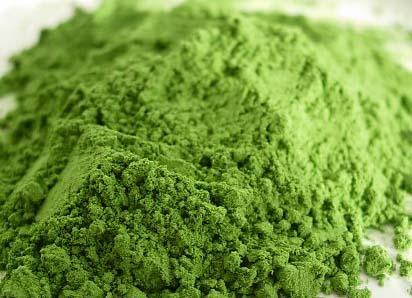Wheatgrass, or wheat grass, has a great many fans. Some even grow their own, and then juice it, taking a small shot every morning to start their day.
It is derived from the common wheat plant,
triticum aestivum. In Thailand’s top private hospital, Bumrungrad, they have a restaurant and juice bar. There they claim that ’wheatgrass has 32 times the concentration of chlorophyll of broccoli, helps oxygenate the blood, improve digestion (and even heal ulcers and collitis) and contains all the vitamins, enzymes and protein you could need’.
 So what’s the truth?
So what’s the truth? Wheatgrass has many devotees. It rose to fame after Charles Schnabel used wheatgrass to feed his chickens in the 1930’s and saw healthier birds and egg production. The dried grass then came to the attention of health workers.
Memorial Sloan Kettering has conducted research on the benefits in collitis and stomach and intestinal disorders. In 2005 the American Nutritional Society published a paper on the benefits of chlorophyll in colon cancer.
Other fans argue for its benefits in oxygenating and purifying the blood. One study showed that it did indeed reduce levels of anaemia. (2004, Thalessemia)
A 2007 study with breast cancer patients on chemotherapy showed that those who consumed wheatgrass needed less bone and blood strengthening drugs.
And several studies show that wheatgrass does seem to have a cleansing, chelating effect with toxins and particularly iron.
However, whilst it is full of vitamins, enzymes and proteins, it contains no vitamin B-12 and nutritionally research shows it is not greater than the juices of other vegetables, although it does have a high and beneficial chlorophyll content.
ChlorophyllThis is a very important natural molecule - it is four molecules surrounding a central atom rather like haemoglobin, the latter having iron at the centre, while chlorophyll has magnesium. The central farming belt of America has a population showing lowered cancer risk, which some experts attribute to the population’s high vegetable intake coupled with an outdoor sunshine-filled life. Sunlight on chlorophyll causes oxygen release. Studies on wheat grass show its ability to oxygenate the blood.
The high fibre content will also help bind to toxins inside the blood stream and gut, and help eliminate them from the body.
A third benefit relates to the general benefit of vegetables and particularly ’greens’. That is their ability to boost glutathione levels. Glutathione is incredibly important inside your cells. It is a powerful antioxidant, and neutraliser of free-radicals. It can actually neutralise toxins inside the cell.
If you are already thinking of buying Wheatgrass,you might like to look at the
Natural Selection shop where they have a whole section on greens. Do it by
clicking here.********************************************
People who read this article, also read:
Glutathione -
CLICK HERE to read this article
A Clean, Efficient Liver -
CLICK HERE to read this article
Chlorella -
CLICK HERE to read this article
.jpg) .
. At Last - the definitive, research based book on how to build a diet to help beat cancer Click here to read about it.
At Last - the definitive, research based book on how to build a diet to help beat cancer Click here to read about it.
Please be clear: At CANCERactive we do not consider the above compound to be a cure for cancer, despite what the research says or experts doing the research may claim. The above, is an article on the compound from published research and expert opinion in the public domain. At CANCERactive we do not believe that any single compound (drug, vitamin, whatever) is a cure for cancer. We believe that people can significantly increase their personal odds of survival by building an Integrated Programme of treatments. Equally, cancer prevention is best practiced through a width of measures.